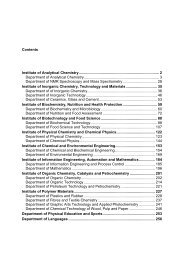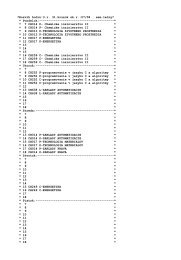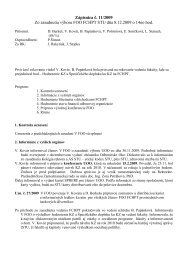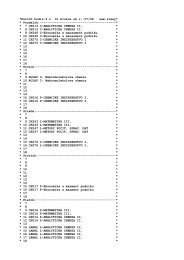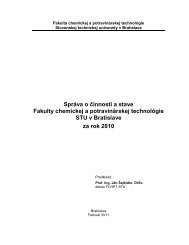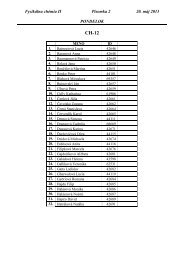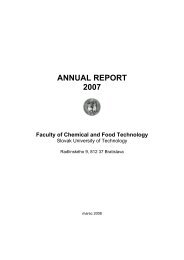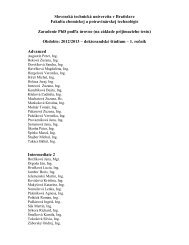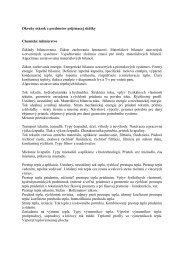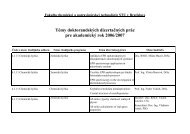rok 2006 - Fakulta chemickej a potravinárskej technológie ...
rok 2006 - Fakulta chemickej a potravinárskej technológie ...
rok 2006 - Fakulta chemickej a potravinárskej technológie ...
Create successful ePaper yourself
Turn your PDF publications into a flip-book with our unique Google optimized e-Paper software.
VEGA Project No. 1/1382/04 Advanced methods for water, wastewater, sludge and organic<br />
wastes treatment (Ján Derco)<br />
Addition of silicate rocks in order to intensify processes of nutrient removal is insufficient and expensive. More<br />
convenient is performance of nitrification and denitrification processes in sludge water in separated reactor with<br />
activated sludge regeneration and phosphorus precipitation in sludge water after sludge stabilisation. Control of<br />
the second step of denitrification process is realistic but too complicated. More appropriate is to optimise<br />
denitrification process by using convenient external organic carbon source for complete denitrification with regard<br />
to actual costs. Anaerobic technology for treatment of corn silage was designed and process parameter values<br />
were determined. Parameter values obtained from laboratory investigation of treatment of organic solid wastes<br />
were used for design, construction and starting-up of full-scale station for biogas production. From results of<br />
testing of anaerobic-aerobic wastewater treatment technologies for small pollution sources followed satisfactory<br />
results in all pollution indicators. Anaerobic baffled reactor is convenient for degradation of<br />
hexamethylenetetramine. Increase of removal efficiency and biodegradability enhancement of biologically<br />
resistant and priority pollutants were achieved by oxidation with ozone and modified procedures of the Fenton<br />
reaction. Significant increase of treatment efficiency of the Fenton reaction was observed after addition of<br />
catechol and hydroquinone.<br />
Project duration: from 01.01.2004 to 31.12.<strong>2006</strong><br />
APVV project No. APVT-20-029804: Functional supramolecular surface nanostructure on the<br />
basis of cyclodextrins (Dušan Velič, Josef Prousek)<br />
J. Prousek participation: The study of the radical reactions influence on the stability of cyclodextrin and<br />
cyclodextrin´s complexes. For this purpose the utilization of Fenton reaction has been tested as a source of<br />
reactive hydroxyl radicals.<br />
Project duration: from 01.01.2005 to 31.12.2007<br />
APVV project No. APVV-20-000705 Rapid gas chromatography-mass spectrometry for<br />
analysis of selected organic pollutants in environmental and food matrices (Eva Matisová,<br />
Josef Prousek)<br />
J. Prousek participation: Evaluation of environmental estrogens with endocrine disruptor activity in environmental<br />
and food matrixes. The utilization of different AOP processes for their degradation.<br />
Project duration: from 01.01.<strong>2006</strong> to 31.12.2008<br />
VEGA project No. VEGA 1/2462/05 Sensors of chemical toxicity - ascertaining of selected<br />
environmental chemical risk factors by the use of biosensors based on DNA and LDL (Ján<br />
Labuda, Josef Prousek)<br />
J. Prousek participation: The study of different antioxidant and prooxidant activity of some natural phenolic<br />
compounds by the use of Fenton reaction. Further, literature study of environmental pollutants with carcinogenic<br />
activity such are nitroaromatics and polyaromatic hydrocarbons, metals and chlorinated compounds.<br />
Project duration: from 01.01.2005 to 31.12.2007<br />
Bilateral Slovak – Slovene Science and Technology Co-operation Project No. SK-SI-01506:<br />
Development of methodology for evaluation of biodegradability of wastewaters after oxidation<br />
treatment (Ján Derco)<br />
The main goal of the project is to set up appropriate methodology for evaluation of economically and ecologically<br />
applicable treatment methods by means of advanced chemical oxidation processes for heavily polluted industrial<br />
wastewaters as well as landfill leachates with low biotreatability potential. The chemical oxidation processes are<br />
studied as possible independent or pretreatment methods before biological treatment. The study will be<br />
conducted also with synthetic and actual wastewaters. Biotreatability of the wastewaters will be evaluated prior<br />
and after optimised chemical pretreatment using complex toxicity and biodegradability assessment. Those<br />
characteristics are considered as key summary factors for effective performance of biological wastewater<br />
treatment plant. It is expected that combination of both treatment methods will lead not only to pollution prevention<br />
but also to the overall cost management of related wastewater treatment plants. Methodology will gain knowledge<br />
on wastewater treatment and it will improve understanding of behaviour of the heavily polluted persistent<br />
wastewaters.<br />
113



